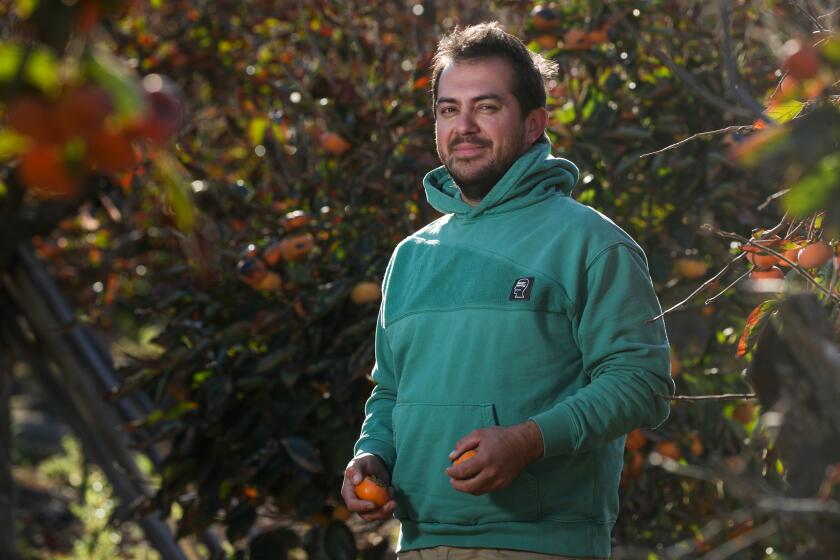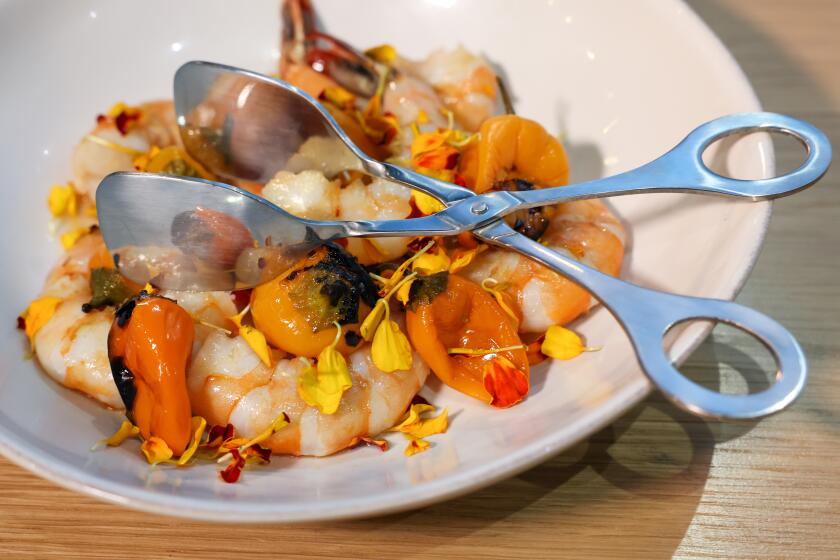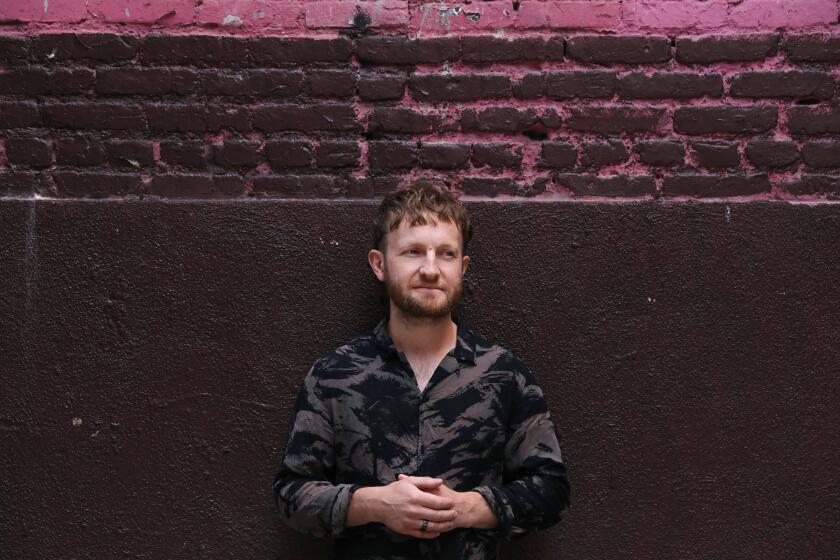
- Share via
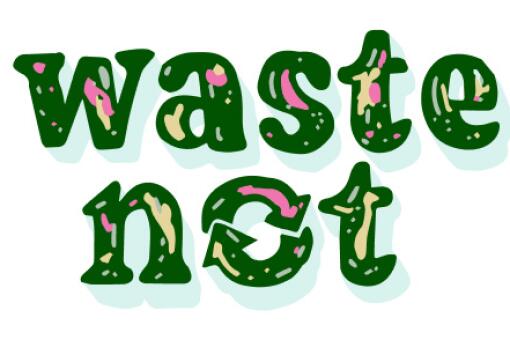
ONGOING SERIES
Conversations about food, the environment and our future.
Diners expect line-caught seafood, locally harvested shellfish and a rooftop garden system from Michael Cimarusti and his Michelin-starred restaurant, Providence. What they might not know is that the chocolate in their dessert is as central to the restaurant’s approach to sustainability, though it’s a bit more sugar-coated than the week’s fresh catch.
In 2022 the restaurant bordering Hollywood and Hancock Park launched a new, no-waste chocolate program that sources directly from cacao farmers who practice sustainable growing, then processes and utilizes every morsel of the beans: Beans are processed to nibs, which become desserts and confections; powdered byproduct is used in baking and sauces; and even the empty husks, often discarded, are transformed into an elegant end-of-meal tea service.
“One of the great parts about being able to source our own cacao is once it comes here, 100% of it is not wasted,” said Mac Daniel Dimla, the executive pastry chef of Providence and architect of the new initiative. “Pretty much there’s nothing that leaves this building — unless you take it home.”
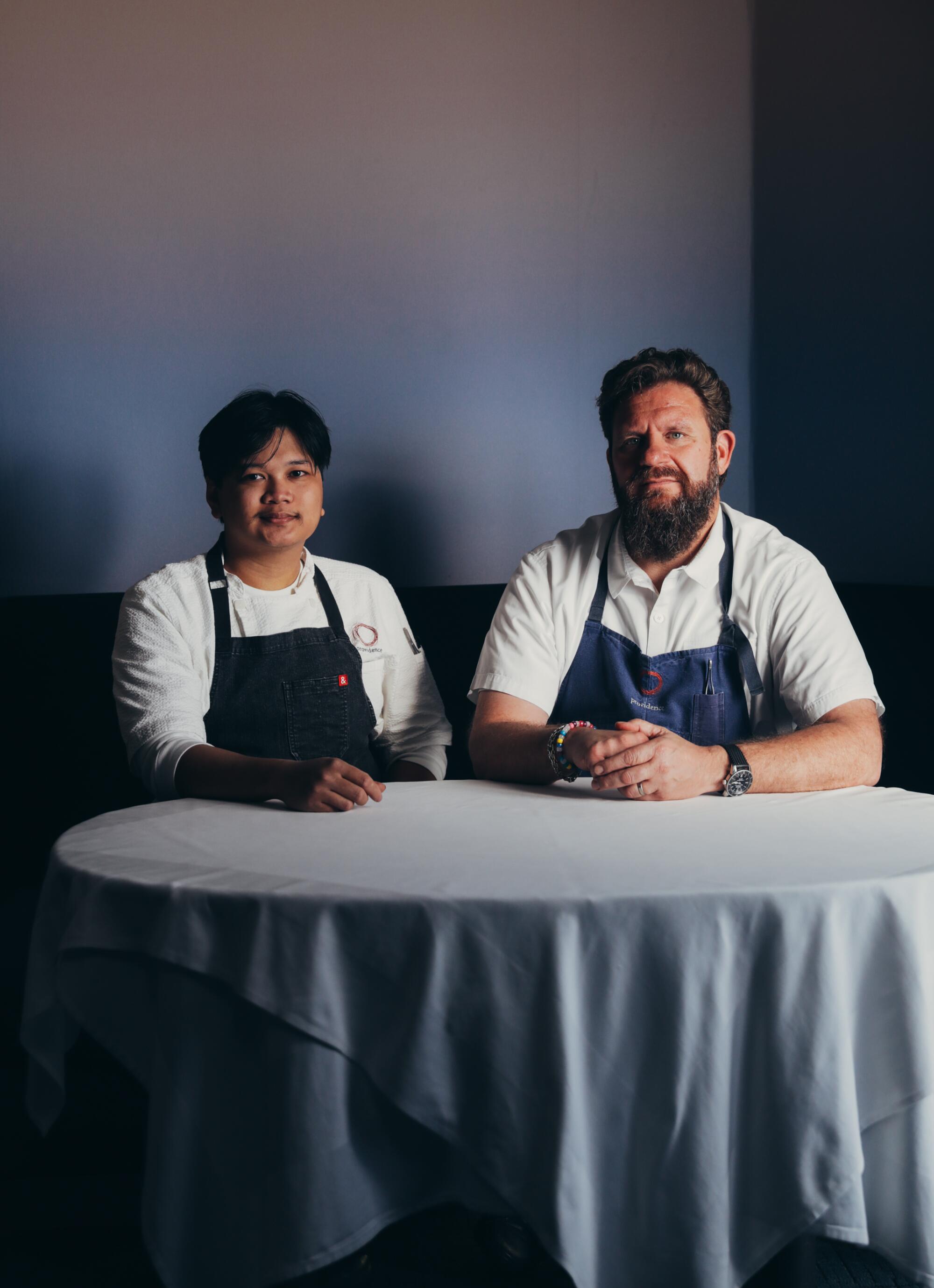
Dimla’s new chocolate program echoes the ethos of longtime sustainable-seafood champion Cimarusti and the practices he has employed at Providence for nearly 20 years. Each year, it seems these efforts grow. The kitchen tries to reuse everything: Fish trim is ground and frozen, then used to clarify consommés, while the bones and skin make broth. They compost. Their rooftop garden grows trellises of herbs. Beehives provide honey for the restaurant.
Chef Balo Orozco started Sunset Cultures, a kombucha-and-condiments business, helping local farmers — and the environment — along the way
“We try to be as careful as we can about purchasing, but whatever we have left at the end of the week we just divvy it up among the staff that’s here at the end of the night and let people take stuff home,” Cimarusti said. “I’d always rather give it away than throw it away. We do things in the kitchen, like what Mac’s doing with the chocolate; that really helps. But I can’t take any credit for any of what he’s doing.”
Dimla is shy to take the credit, but the fruits of his efforts are worth praising. He starts with Hawaiian cocoa beans — a stellar, small-farm product, which he helps to guide during its growing stage — then makes the chocolate by hand, a multiday process.
The resulting magnificence is fleeting. It’s ephemeral, almost designed to be: It leaves a light, smooth coating on the tongue, not too thick as it melts and not too lingering in its bright, nutty flavor. That, Dimla says, is the intention. He loves using it in pastry because it feels like a blank canvas for him to paint with flavor.
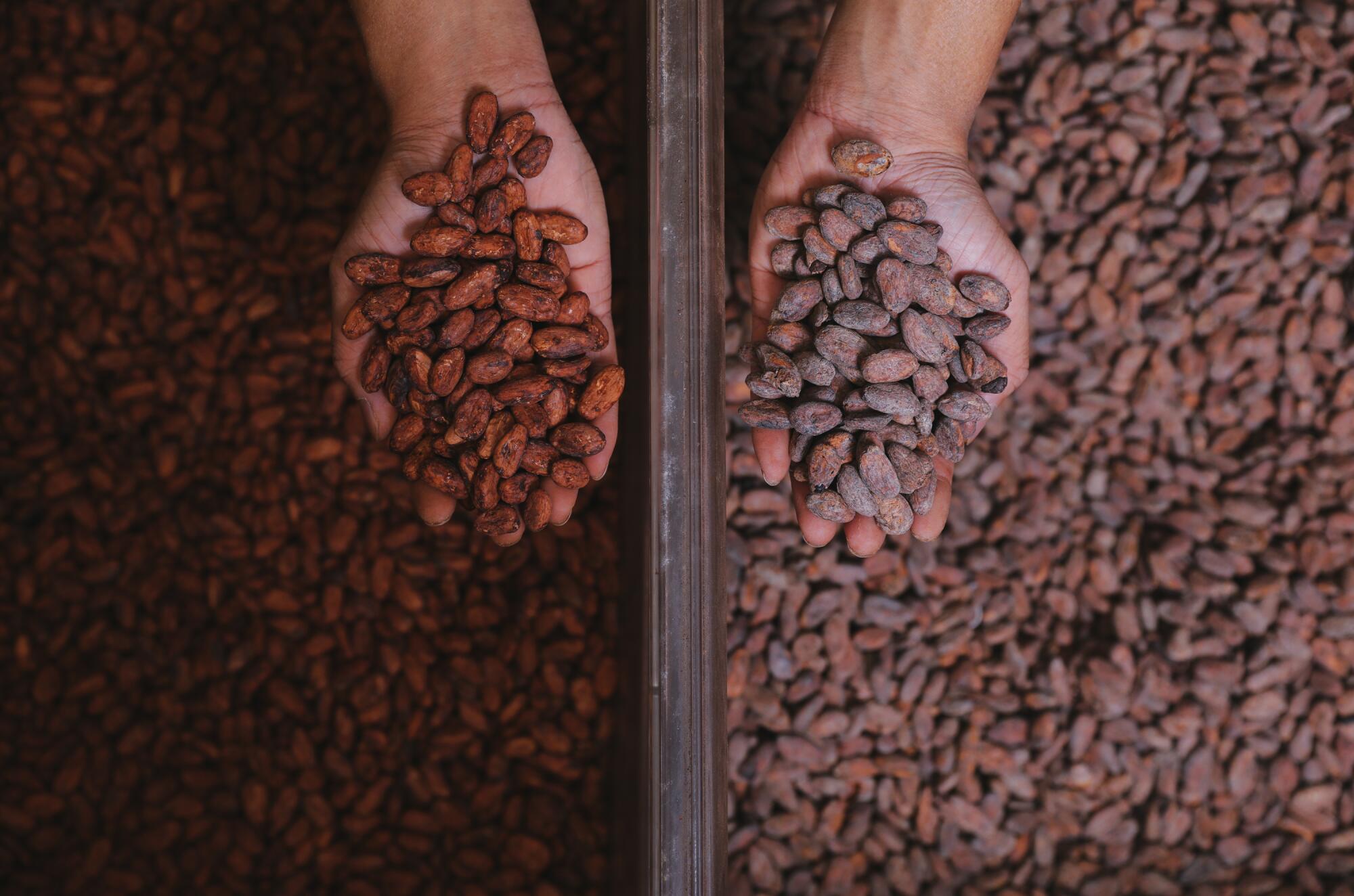
Dimla’s awareness of sustainable cooking sprouted in 2014, when he moved from Guam to California to study at the Culinary Institute of America in Napa. A farm on the campus instructed students in the ways of farm-to-table cooking practices, while its kitchens encouraged them to use every part of every ingredient and to compost. It was then he realized that cooking sustainably wasn’t simply good for the environment — it saved money and could fortify soil used for growing one’s own produce too. The lessons stuck with him, both on and off the clock; in his own home, the young pastry chef says he keeps four bins for sorting food waste and recyclables.
Dimla’s education and sustainability awareness grew in New York City, where he externed at Marea and staged at Per Se. He returned to Napa, then moved to Los Angeles, where he worked in the kitchens of Kali and République. In his studies Dimla had focused on savory, not dessert, but he’d dabbled; in 2016, two of his friends worked at Providence as pastry chef and pastry sous and asked if he might help at the restaurant. By spring of 2018, at the age of 23, he took on the role of Providence’s executive pastry chef himself.
The chefs behind Slow Burn hit the road with their mobile larder — jars of every bit of every ingredient preserved — toward a zero-waste future.
He didn’t begin his tenure with a no-waste chocolate program, but he did set the wheels in motion early.
Wanting to install a sustainability-minded dessert program from the moment he took the pastry reins, when he assumed the role Dimla switched the restaurant’s sourcing priorities: Why order high-end purées from France and other Michelin-starred restaurants elsewhere in the U.S. when purchasing fruits more locally can help curb a carbon footprint and support the local produce economy? Dimla’s focus also zeroed in on waste reduction, with a twofold purpose: Using every morsel of an ingredient not only diminishes food waste but also provides a more potent flavor.
A no-waste mango dish, for instance, slices the meat of the fruit, then repurposes excess as purée for nectar or sorbet, while tapioca pearls are soaked in a syrup made from the mango skins and pith. When the kitchen notices an excess of syrup, it’s used elsewhere, such as in a house-made yogurt.
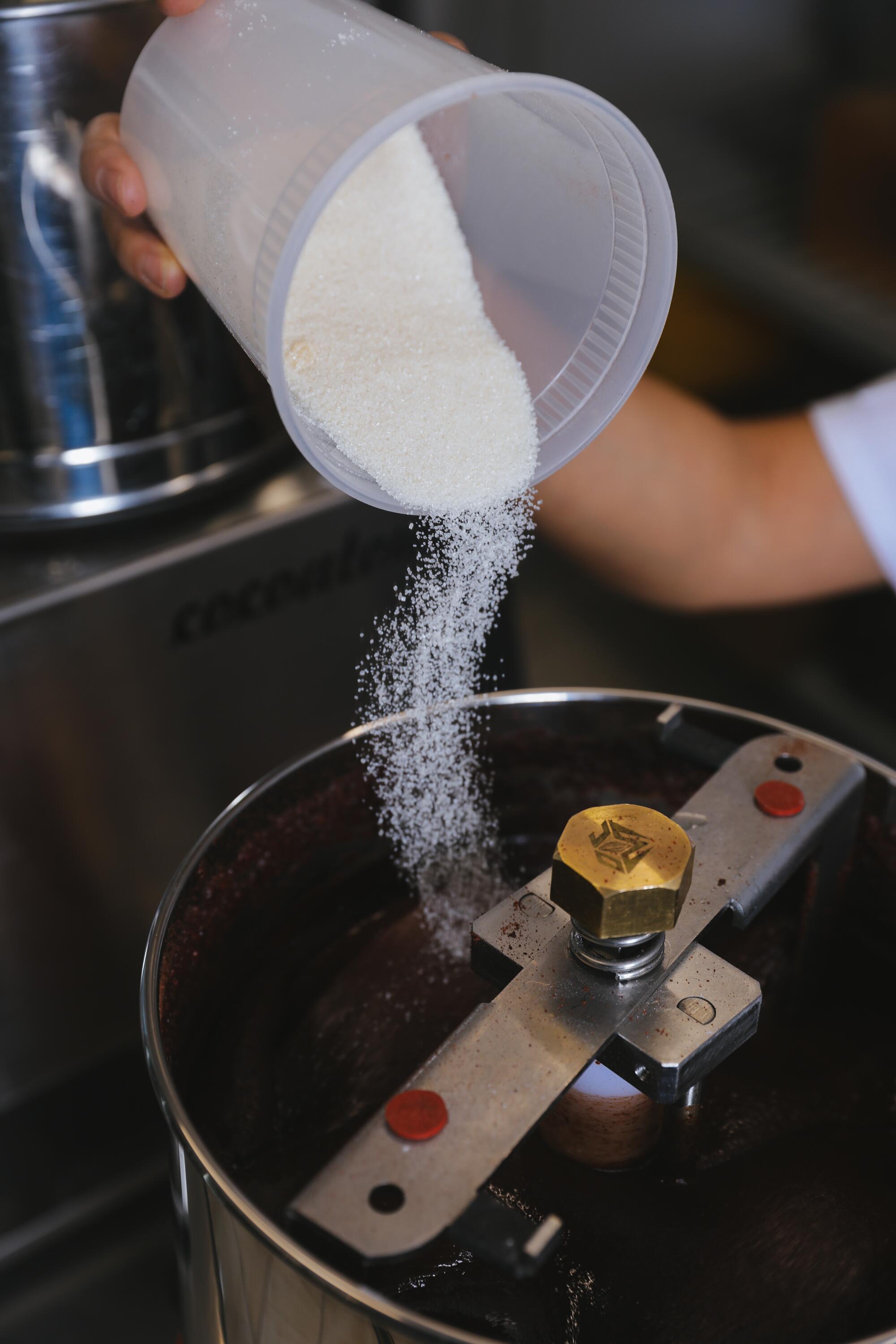
While Dimla is in no way thankful for the pandemic, the restaurant’s temporary closure provided the time to design the zero-waste chocolate program, as did a slow return to form. Before the pandemic, Providence was doing 140 covers. Upon reopening, it scaled back to half that number of seatings, which gave Dimla more breathing room to devote to in-house processes, in some cases literally building them by hand.
The cacao’s journey to Providence — and your plate — begins months before it’s enjoyed. Dimla primarily sources from Mauna Kea Cacao, the 20-acre farm of a husband-and-wife team on the Hamakua coast, which checks multiple boxes: The product’s taste and quality is to Dimla’s standards, it keeps money in the local economy, the proximity to L.A. allows for regular visits, it’s sustainably farmed and, by cornering much of a small farm’s output at a premium price, he’s able to help steer the process. The pastry chef estimates the farm sends 80% of its output to Providence. He remains in contact with farmers John and Susan Bassett through the growth period to guide flavor profiles and output. Once the cacao arrives, the beans are roasted in the kitchen oven downstairs for roughly half an hour to soften any lingering acidity from their fermentation process and to develop flavor. They’re then broken into smaller pieces using a juicer commandeered from the kitchen downstairs, and then winnowed to fully separate the nib from the husk.
He’s sure there’s a machine one can buy to winnow, but Dimla jury-rigged his own from a large white plastic bucket, whose lid spouts a series of valves: one for a kind of chute at the side, where the cacao is inserted in batches, and another for a small handheld vacuum’s arm to pull air that draws the husks — which weigh less than the nibs — up through a curved tube and into the bucket, while the nibs, too heavy for the vacuum’s suction, fall through the side chute and onto the table.
The nibs can be used as is but here are typically processed into chocolate for desserts. The husks can become the after-dinner tea, and the little that finds itself in the vacuum’s bag is, in essence, a fine cocoa powder, which also is used by the team. A high-temperature food processor, also nabbed from the restaurant’s kitchen, helps separate the nibs’ fats from the solids, creating a kind of loose, textured paste.
On the center table of an upstairs alcove used for dry storage, dry-aging seafood and accessing the rooftop herb garden and beehives, two machines whir. To process the nibs, the team gradually adds the paste and liquefied cocoa butter to these melangers, which spin constantly for three days. Their rotating granite wheels help to break down any larger pieces until the cacao forms an endlessly flowing churn of liquid chocolate, silken and just slightly bubbling at the surface.
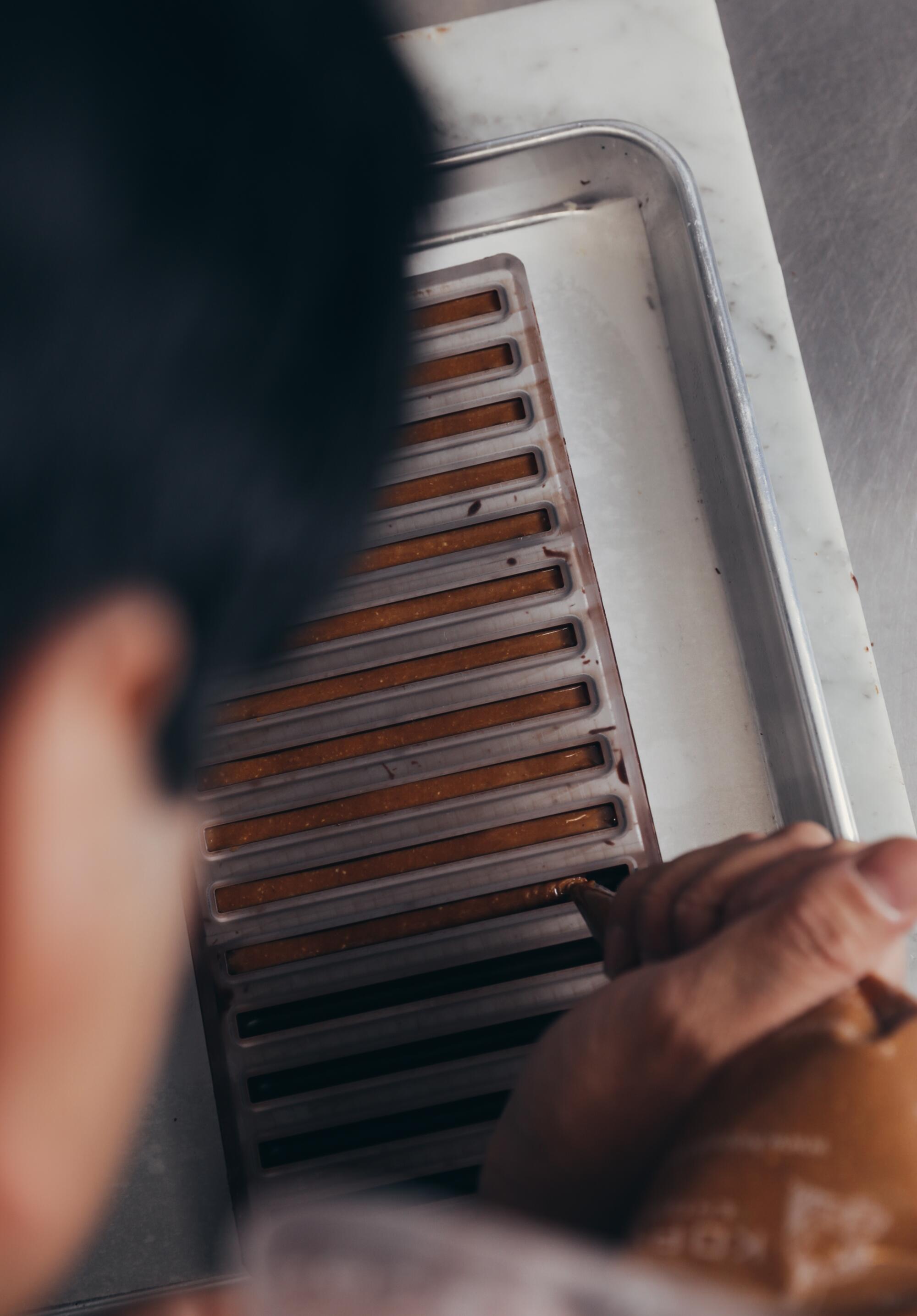
Once it’s finished, Dimla pulls out a grindometer — a small, flat slab that almost resembles a thermometer — which is used to determine the microns of the chocolate or the fineness of the finished product. A small dab of the liquid chocolate gets spread evenly across the center of the surface, its user measuring where the slick begins to break from its cohesive streak. Once he determines the chocolate is the right texture and fineness, it waits in vats, heated, to be ladled out and turned into some of the city’s most luxurious desserts and confections: thin, delicate matchsticks of chocolate packed with sweet-salty sesame butter, or little flower-shaped truffles filled with sunflower praline and “providence” printed onto the bottom of the treat.
Eventually, Dimla says, he hopes to create chocolate bars for the restaurant, whether for retail or as gifts for guests. He’s been experimenting with biodegradable packaging for them: boxes of recycled paper, quick-decomposing wrappers, recyclable gold foil. It’s a project he’s been quietly working on for nearly a year, its progress delayed only by a sustainability focus that Dimla — much like the operators of Providence — would rather not sacrifice.
But what of those husks? While the nibs and powder can easily find their way into bars, truffles, cakes and creams, the husks — typically discarded or used as mulch — are brittle, dry and, while edible and packed with nutrients, require a bit of imagination. Dimla’s went to tea.
“It’s very mellowed-down — more light, like a watery cocoa,” Dimla says, “but then we make sort of a cocoa syrup with the husk, and they can sweeten their tea with that.”
The chef of Silo, London’s lauded closed-loop, zero-waste restaurant, shares best practices for food service in L.A. and beyond
The final course of the evening arrives — after processions of scallop swimming in leek fondue, sashimi encircled by satsuma and persimmon nestled under ginger sorbet — as an arrangement of mignardises conceptualized, crafted and molded by Dimla and his pastry team. With it comes the choice of refreshment, and with that comes the option of the restaurant’s new mint-and-cacao tea, which steeps the husks winnowed and discarded upstairs into a comforting, aromatic tea downstairs, the cocoa-bean shells lending a sweet aroma to the flavor of fistfuls of fresh mint grown in the rooftop garden, also steeped into the blend.
None of this is mentioned on the menu, but should guests wish to know more, the staff will share. Dimla is proud of his new program and the restaurant’s broader sustainability efforts, though like Cimarusti, he’s not so much coy about their successes as he is reluctant to rest on his laurels. There is always more food waste to curb, not only to combat the nearly 1.5 billion tons of food discarded globally each year but to coax new flavors and imagine new dining possibilities. It helps that here, in Dimla’s hands, sustainability tastes pretty sweet.
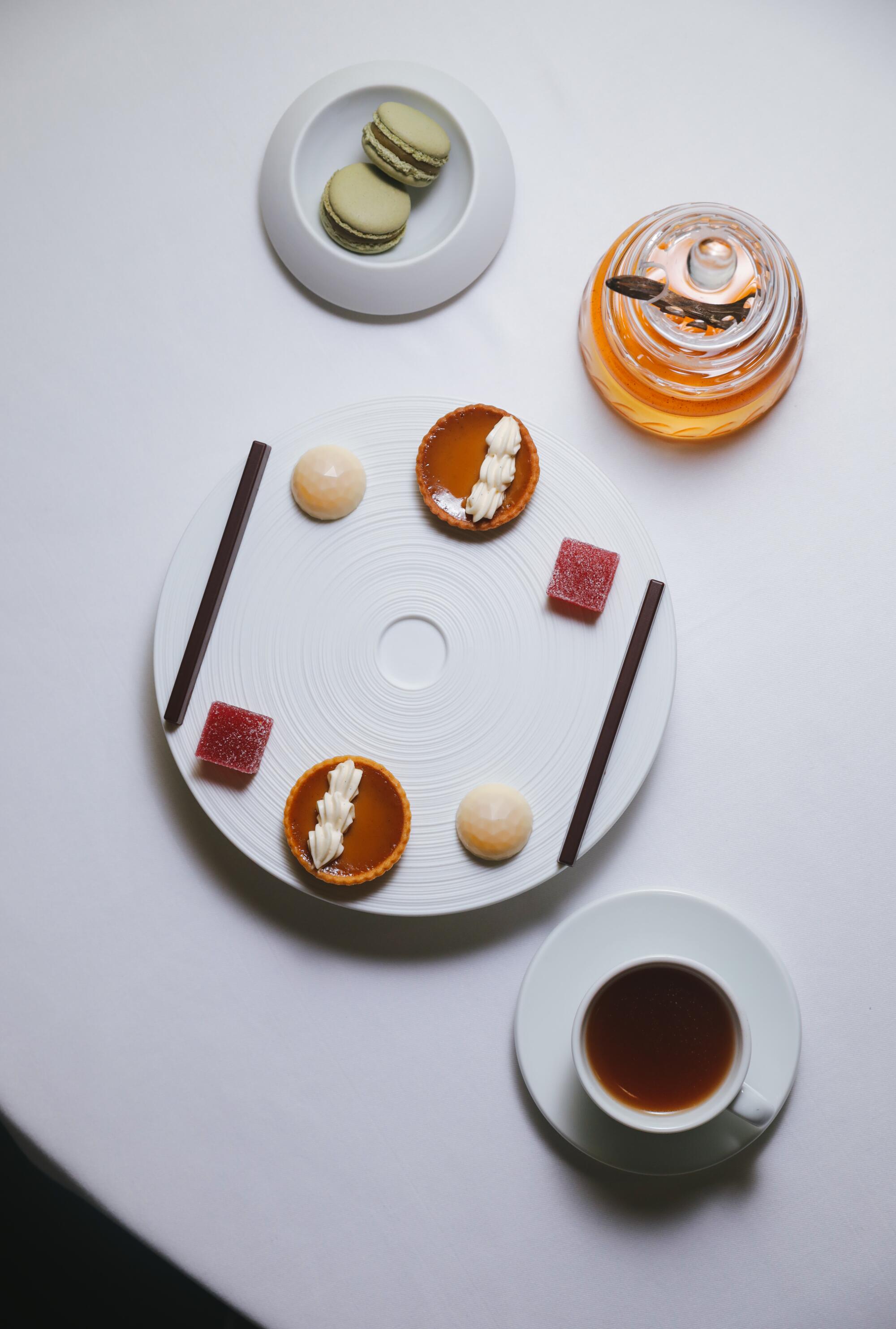
More to Read
Eat your way across L.A.
Get our weekly Tasting Notes newsletter for reviews, news and more.
You may occasionally receive promotional content from the Los Angeles Times.
